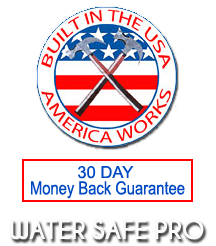UV Or REVERSE OSMOSIS
What is Best for your Water Filtration Needs?
What is Reverse Osmosis?
Reverse osmosis, or hyperfiltration, is the finest filtration available. A reverse osmosis water filter utilizes extreme water pressure to force water molecules through super fine membranes that separate out any contaminant or additives. It is capable of removing particles as small as individual ions and dissolved organic molecules from water. This system differs from a UV water purification system as Reverse osmosis depend directly upon how much water pressure is forced against their internal membrane to determine what is removed from the source water. Ultraviolet water purification relies on UV light to sterilize microorganisms in the water.
How Does a Membrane Separate Substances?
Reverse osmosis uses a membrane that is semi-permeable, allowing water that is being purified to pass through it, while rejecting water contaminants that remain. Most reverse osmosis technology uses a process known as crossflow to allow the membrane to continually clean itself. As the purified water passes through the membrane the rest continues downstream, cleaning the membrane. The process of reverse osmosis requires water pressure to push the water through the membrane. Reverse osmosis is capable of rejecting some bacteria, salts, sugars, proteins, particles, dyes, and other contaminants, depending upon the type of membrane utilized and the level of water pressure within the system.
What does all this mean?
The rate at which a reverse osmosis system is able to create drinking water is very slow, with most units measuring production in terms of gallons per day, not minute, as one finds with UV filtration systems. A standard 35 gallon-per-day system would take nearly three minutes to fill an eight ounce glass of water. Because of this lack of production, a storage tank is utilized, so that the system can filter the water and store it for future use. However, these tanks pose several challenges. After the chlorine has been removed from the water by the filtering process, the water is pumped into the storage tank, where it mixes with old water until it is needed. Meanwhile, this warm, dark tank is exactly the right environment for bacteria, viruses, algae, and other life forms to breed and multiply. Also, by the nature of the reverse osmosis process, a standard R.O. system "flushes" nearly five times as much water as it creates - with a system operating at 35 gallons per day wasting around 5 times that much, as much as 64k gallons per year.
Reverse Osmosis Benefits and Drawbacks, Benefits of an RO system are the ability to remove all contaminants such as salt, lead, arsenic and chemicals. Drawbacks include bacterial bypass and contamination/growth of bacteria in the storage tank, the extremely slow production rate of water, removal of beneficial minerals and The High Cost of RO filter systems.
UV Water Filtration Benefits and Drawbacks: Benefits of a UV water filtration system is total sterilization of the water IE no microorganisms present at all, water production at high rates, low cost of the system and components. The main drawback compared to an RO systems are the inability to remove chemicals, dissolved solids and metals.
So what do i do if I already own an R.O. system?
Depending on an individual's circumstances, there may be several. First, if you already own an RO system, make certain your system has an automatic shut-off valve so that it does not continue wasting water even when the tank is full (which would only compound the above mentioned issue) and consider installing a Water Safe Pro UV Chamber only between the tank and your faucet. This allows you to utilize your current system while avoiding any possible microorganism exposure from your holding tank or which has passed through the membrane (such as viruses). Because UV exposure does not alter the taste of the water it treats, if the water coming from your tank tastes "flat" or "sour", this is most likely caused by the growth of algae in your tank. This can be easily remedied by selecting a Water Safe Pro UV Model 200, as it includes a micro-filtration carbon filter designed to screen contaminants such as algae and to remove any unpleasant tastes and odors. Finally, if your source water Does Not contain harmful dissolved solids, consider the annual cost of maintaining your RO system combined with the amount you would save with a reduced water bill against the price of a Water Safe Pro UV system.


